Showing Spotlights 193 - 200 of 237 in category All (newest first):
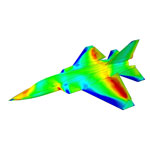 'Smart' is the key buzz word used by materials engineers when they describe the future of coatings, textiles, building structures, vehicles and just any material that you can think of. Materials are made 'smart' when they are engineered to have properties that change in a controlled manner under the influence of external stimuli such as mechanical stress, temperature, humidity, electric charge, magnetic fields etc. Smart materials have some form of sensor capability that detects a change in the material or its environment that then triggers some kind of action. Not only for use in smart materials but as general sensor materials, especially for monitoring large areas, the development of materials that act as 'chemical paints' - or coatings - by responding to a (bio)chemical parameter with a change in their optical properties has developed into an exciting new field. In a typical application, the object of interest is painted and the color or fluorescence of the paint is monitored by methods of optical imaging. This technique represents a simple but exciting new technology to monitor (bio)chemical and even physical parameters over relatively large areas and in real time without having to look at only a minute sample through a microscope.
'Smart' is the key buzz word used by materials engineers when they describe the future of coatings, textiles, building structures, vehicles and just any material that you can think of. Materials are made 'smart' when they are engineered to have properties that change in a controlled manner under the influence of external stimuli such as mechanical stress, temperature, humidity, electric charge, magnetic fields etc. Smart materials have some form of sensor capability that detects a change in the material or its environment that then triggers some kind of action. Not only for use in smart materials but as general sensor materials, especially for monitoring large areas, the development of materials that act as 'chemical paints' - or coatings - by responding to a (bio)chemical parameter with a change in their optical properties has developed into an exciting new field. In a typical application, the object of interest is painted and the color or fluorescence of the paint is monitored by methods of optical imaging. This technique represents a simple but exciting new technology to monitor (bio)chemical and even physical parameters over relatively large areas and in real time without having to look at only a minute sample through a microscope.
Sep 26th, 2008
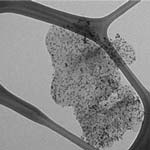 Carbon nanomaterials have been extensively used in electroanalysis, and the most common forms are spherical fullerenes, cylindrical nanotubes, and carbon fibers and blacks. Since the discovery that individual carbon nanotubes (CNTs) can be used as nanoscale transistors, researchers have recognized their outstanding potential for electronic detection of biomolecules in solution, possibly down to single-molecule sensitivity. To detect biologically derived electronic signals, CNTs are often functionalized with linkers such as proteins and peptides to interface with soluble biologically relevant targets. Now, for the first time, scientists have tested nanometal decorated graphene (actually graphite nanoplatelets, a thickness of 10 nm would contain approximately 30 graphene sheets, considering an interlayer spacing of 0.335 nm) in biosensor application. As it turned out, this novel biosensor is among the best reported to date in both sensing performance and production cost.
Carbon nanomaterials have been extensively used in electroanalysis, and the most common forms are spherical fullerenes, cylindrical nanotubes, and carbon fibers and blacks. Since the discovery that individual carbon nanotubes (CNTs) can be used as nanoscale transistors, researchers have recognized their outstanding potential for electronic detection of biomolecules in solution, possibly down to single-molecule sensitivity. To detect biologically derived electronic signals, CNTs are often functionalized with linkers such as proteins and peptides to interface with soluble biologically relevant targets. Now, for the first time, scientists have tested nanometal decorated graphene (actually graphite nanoplatelets, a thickness of 10 nm would contain approximately 30 graphene sheets, considering an interlayer spacing of 0.335 nm) in biosensor application. As it turned out, this novel biosensor is among the best reported to date in both sensing performance and production cost.
Sep 8th, 2008
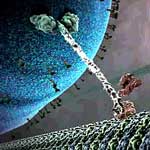 Borrowing from nature's micro- and nanoscale propulsion systems, nanotechnology researchers have successfully used motor proteins to transport nanosized cargo in molecular sorting and nano-assembly devices. In so-called gliding assays, surface-attached motors propel cytoskeletal filaments, which in turn transport a cargo. However, cargo and motors both attach to the filament lattice and will affect each other. While an effect of cargo loading on transport speed has been described before, it has never been explained very well. To study this effect, scientists in Germany have observed single kinesin-1 molecules on streptavidin coated microtubules. They found that individual kinesin-1 motors frequently stopped upon encounters with attached streptavidin molecules. This work helps to understand the interactions of kinesin-1 and obstacles on the microtubule surface. An interesting, possibly even more important side result is that this understanding will not only help to optimize transport assays, balancing speed and cargo-loading, but can be used as a novel method for the detection of proteins as well.
Borrowing from nature's micro- and nanoscale propulsion systems, nanotechnology researchers have successfully used motor proteins to transport nanosized cargo in molecular sorting and nano-assembly devices. In so-called gliding assays, surface-attached motors propel cytoskeletal filaments, which in turn transport a cargo. However, cargo and motors both attach to the filament lattice and will affect each other. While an effect of cargo loading on transport speed has been described before, it has never been explained very well. To study this effect, scientists in Germany have observed single kinesin-1 molecules on streptavidin coated microtubules. They found that individual kinesin-1 motors frequently stopped upon encounters with attached streptavidin molecules. This work helps to understand the interactions of kinesin-1 and obstacles on the microtubule surface. An interesting, possibly even more important side result is that this understanding will not only help to optimize transport assays, balancing speed and cargo-loading, but can be used as a novel method for the detection of proteins as well.
Sep 4th, 2008
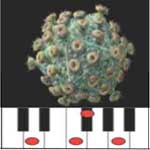 Detecting the presence of a given substance at the molecular level, down to a single molecule, remains a considerable challenge for many nanotechnology sensor applications that range from nanobiotechnology research to environmental monitoring and antiterror or military applications. Currently, chemical functionalization techniques are used to specify what a nanoscale detector will sense. For biological molecules, this might mean developing an antibody/antigen pair, or an alternative synthetically generated ligand. For chemical gases, it is much more challenging to develop the right 'glue' that sticks a given gas to a substrate. The advantage of spectroscopic techniques such as Raman, infrared, and nuclear magnetic resonance spectroscopy is that they are label-free, i.e. they require no preconditioning in order to identify a given analyte. They are also highly selective, capable of distinguishing species that are chemically or functionally very similar. On the downside, spectroscopic methods face enormous challenges in measuring dilute concentrations of an analyte and generally involve the use of large, expensive equipment. This article describes a novel chemical detection technique called nanomechanical resonance spectroscopy.
Detecting the presence of a given substance at the molecular level, down to a single molecule, remains a considerable challenge for many nanotechnology sensor applications that range from nanobiotechnology research to environmental monitoring and antiterror or military applications. Currently, chemical functionalization techniques are used to specify what a nanoscale detector will sense. For biological molecules, this might mean developing an antibody/antigen pair, or an alternative synthetically generated ligand. For chemical gases, it is much more challenging to develop the right 'glue' that sticks a given gas to a substrate. The advantage of spectroscopic techniques such as Raman, infrared, and nuclear magnetic resonance spectroscopy is that they are label-free, i.e. they require no preconditioning in order to identify a given analyte. They are also highly selective, capable of distinguishing species that are chemically or functionally very similar. On the downside, spectroscopic methods face enormous challenges in measuring dilute concentrations of an analyte and generally involve the use of large, expensive equipment. This article describes a novel chemical detection technique called nanomechanical resonance spectroscopy.
Aug 27th, 2008
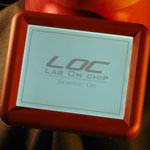 The term biosensing relates to systems that include electronic, photonic, biologic, chemical and mechanical means for producing signals that can be used for the identification, monitoring or control of biological phenomena. The resulting biosensors are devices that employ biological components such as proteins to provide selectivity and/or amplification for the detection of biochemical materials for use in medical diagnostics, environmental analysis or chemical and biological warfare agent detection. Surface plasmon resonance (SPR) has become the technology of choice for label-free detection of proteins and other biomolecules. SPR is based on the excitation of a surface plasmon at the interface between a dielectric and a thin layer of metal, typically gold. Once the sample is covered with the nanostructured gold layer (or another suitable metal), the surface absorbs light at certain wavelength. The absorption maximum is influenced by the refractive index of the fluid at the gold surface. This effect is called localized surface plasmon resonance (LSPR) and it is used for detection of presence of biomolecules, such as specific proteins.
The term biosensing relates to systems that include electronic, photonic, biologic, chemical and mechanical means for producing signals that can be used for the identification, monitoring or control of biological phenomena. The resulting biosensors are devices that employ biological components such as proteins to provide selectivity and/or amplification for the detection of biochemical materials for use in medical diagnostics, environmental analysis or chemical and biological warfare agent detection. Surface plasmon resonance (SPR) has become the technology of choice for label-free detection of proteins and other biomolecules. SPR is based on the excitation of a surface plasmon at the interface between a dielectric and a thin layer of metal, typically gold. Once the sample is covered with the nanostructured gold layer (or another suitable metal), the surface absorbs light at certain wavelength. The absorption maximum is influenced by the refractive index of the fluid at the gold surface. This effect is called localized surface plasmon resonance (LSPR) and it is used for detection of presence of biomolecules, such as specific proteins.
Aug 4th, 2008
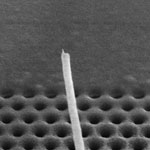 Much is being written about nanotechnology's role in vastly improving the detection and treatment of cancer. Detection of cancer at the earliest stage provides the greatest chance of survival. Unfortunately, cancer has a logarithmic growth rate. A one cubic centimeter size tumor may have 40-50 cell divisions and typically doctors don't see 80% of the life of a tumor. The detection of a protein pattern in blood serum can be helpful in evidencing a possible presence of cancer at an early stage. The problem is that 'early' means the capability of detecting very few molecules in dilute conditions. Now, in another step to improve the design and fabrication of devices for single molecule detection, new research has demonstrated an experimental capability of detecting down to as few as 10 organic molecules deposited on a quantum dot.
Much is being written about nanotechnology's role in vastly improving the detection and treatment of cancer. Detection of cancer at the earliest stage provides the greatest chance of survival. Unfortunately, cancer has a logarithmic growth rate. A one cubic centimeter size tumor may have 40-50 cell divisions and typically doctors don't see 80% of the life of a tumor. The detection of a protein pattern in blood serum can be helpful in evidencing a possible presence of cancer at an early stage. The problem is that 'early' means the capability of detecting very few molecules in dilute conditions. Now, in another step to improve the design and fabrication of devices for single molecule detection, new research has demonstrated an experimental capability of detecting down to as few as 10 organic molecules deposited on a quantum dot.
Jul 23rd, 2008
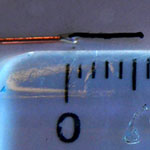 Carbon nanotubes (CNTs) have been widely used as electrodes for chemical and biological sensing applications and many other electrochemical studies. With their unique one-dimensional molecular geometry of a large surface area coupled with their excellent electrical properties, CNTs have become important materials for the molecular engineering of electrode surfaces where the development of electrochemical devices with region-specific electron-transfer capabilities is of paramount importance. It has been demonstrated that carbon nanotubes enhance the electrochemical activity of biomolecules and promote the electron-transfer reactions of redox proteins, such as myoglobin, cyctochrome c, and microperoxidase MP-11. The enhanced electrochemical activity and electron transfer rate at CNT electrodes have been widely believed to arise from the nanotube tips. However, no convincing experimental evidence has been obtained to prove that the CNT tip is more electrochemically active than its sidewall. Contradicting this common belief, researchers have now found that, surprisingly, the electrochemistry at carbon nanotube electrodes is not always facilitated by the nanotube tip. In fact, the relative electrochemical sensitivity of the nanotube tip and sidewall varies for different electrochemical probes proceeding with different reaction mechanisms.
Carbon nanotubes (CNTs) have been widely used as electrodes for chemical and biological sensing applications and many other electrochemical studies. With their unique one-dimensional molecular geometry of a large surface area coupled with their excellent electrical properties, CNTs have become important materials for the molecular engineering of electrode surfaces where the development of electrochemical devices with region-specific electron-transfer capabilities is of paramount importance. It has been demonstrated that carbon nanotubes enhance the electrochemical activity of biomolecules and promote the electron-transfer reactions of redox proteins, such as myoglobin, cyctochrome c, and microperoxidase MP-11. The enhanced electrochemical activity and electron transfer rate at CNT electrodes have been widely believed to arise from the nanotube tips. However, no convincing experimental evidence has been obtained to prove that the CNT tip is more electrochemically active than its sidewall. Contradicting this common belief, researchers have now found that, surprisingly, the electrochemistry at carbon nanotube electrodes is not always facilitated by the nanotube tip. In fact, the relative electrochemical sensitivity of the nanotube tip and sidewall varies for different electrochemical probes proceeding with different reaction mechanisms.
Jun 26th, 2008
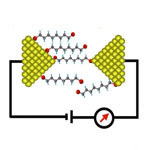 One of the many fascinating concepts in nanotechnology is the vision of molecular electronics where tomorrow's engineers might use individual molecules to perform the functions in an electronic circuit that are performed by semiconductor devices today. This is just another example of scientists taking a cue from nature's playbook, where essentially all electronic processes, from photosynthesis to signal transduction, occur in molecular structures. The basic science on which molecular electronics technology would be built is now unfolding but researchers are still struggling with the most basic requirements for molecular electronics, for instance, how to precisely position individual molecules on a surface or how to reliably measure the resistance of a single molecule. A tremendous amount of painstaking work goes into developing the kind of ultraprecise and ultrasensitive instruments that are required to develop electronics at the nanoscale. A recent example is a new device for measuring the conductance values of single-molecule junctions which are covalently bound to two electrodes.
One of the many fascinating concepts in nanotechnology is the vision of molecular electronics where tomorrow's engineers might use individual molecules to perform the functions in an electronic circuit that are performed by semiconductor devices today. This is just another example of scientists taking a cue from nature's playbook, where essentially all electronic processes, from photosynthesis to signal transduction, occur in molecular structures. The basic science on which molecular electronics technology would be built is now unfolding but researchers are still struggling with the most basic requirements for molecular electronics, for instance, how to precisely position individual molecules on a surface or how to reliably measure the resistance of a single molecule. A tremendous amount of painstaking work goes into developing the kind of ultraprecise and ultrasensitive instruments that are required to develop electronics at the nanoscale. A recent example is a new device for measuring the conductance values of single-molecule junctions which are covalently bound to two electrodes.
May 27th, 2008
 'Smart' is the key buzz word used by materials engineers when they describe the future of coatings, textiles, building structures, vehicles and just any material that you can think of. Materials are made 'smart' when they are engineered to have properties that change in a controlled manner under the influence of external stimuli such as mechanical stress, temperature, humidity, electric charge, magnetic fields etc. Smart materials have some form of sensor capability that detects a change in the material or its environment that then triggers some kind of action. Not only for use in smart materials but as general sensor materials, especially for monitoring large areas, the development of materials that act as 'chemical paints' - or coatings - by responding to a (bio)chemical parameter with a change in their optical properties has developed into an exciting new field. In a typical application, the object of interest is painted and the color or fluorescence of the paint is monitored by methods of optical imaging. This technique represents a simple but exciting new technology to monitor (bio)chemical and even physical parameters over relatively large areas and in real time without having to look at only a minute sample through a microscope.
'Smart' is the key buzz word used by materials engineers when they describe the future of coatings, textiles, building structures, vehicles and just any material that you can think of. Materials are made 'smart' when they are engineered to have properties that change in a controlled manner under the influence of external stimuli such as mechanical stress, temperature, humidity, electric charge, magnetic fields etc. Smart materials have some form of sensor capability that detects a change in the material or its environment that then triggers some kind of action. Not only for use in smart materials but as general sensor materials, especially for monitoring large areas, the development of materials that act as 'chemical paints' - or coatings - by responding to a (bio)chemical parameter with a change in their optical properties has developed into an exciting new field. In a typical application, the object of interest is painted and the color or fluorescence of the paint is monitored by methods of optical imaging. This technique represents a simple but exciting new technology to monitor (bio)chemical and even physical parameters over relatively large areas and in real time without having to look at only a minute sample through a microscope.
 Subscribe to our Nanotechnology Spotlight feed
Subscribe to our Nanotechnology Spotlight feed





